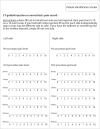Piriformis syndrome: pain response outcomes following CT-guided injection and incremental value of botulinum toxin injection
- PMID: 33252337
- PMCID: PMC7837716
- DOI: 10.5152/dir.2020.19444
Piriformis syndrome: pain response outcomes following CT-guided injection and incremental value of botulinum toxin injection
Abstract
Purpose: Piriformis syndrome is a common pain condition affecting the buttock and posterior hip with or without radiation to the leg, and management of the condition involves many treatments. In this study, we hypothesize that a CT-guided injection with botulinum toxin is more effective in providing pain relief than a CT-guided injection without Botox.
Methods: Overall, 97 consecutive patients with piriformis syndrome presented for a CT-guided injection of the piriformis muscle and perineural injection of the sciatic nerve. After the injection, the patients received a visual analog scale pain log to record their pain level until the follow-up appointment. P values of less than 0.2 were considered as confounder and adjusted by inverse probability of treatment weighting (IPTW) via propensity score. The effect of botulinum toxin on 48-hour response and duration of response was tested using weighted chi-square test and weighted Kaplan-Meier analysis.
Results: There was a total of 97 patients in the study, and 111 injections, as some patients had bilateral injections. Patients in the Botox group had more 48-hour response than patients in the non-botulinum toxin group (P < 0.001 with IPTW, P = 0.005 without IPTW). Median pain-free survival was 30 days for Botox group and 1 day for non-Botox group (P = 0.059 with IPTW, P = 0.10 without IPTW).
Conclusion: CT-guided injections with botulinum toxin for patients with piriformis syndrome are more likely to lead to a positive response and a longer duration of response than patients who receive a CT-guided injection without botulinum toxin. We hope that this study facilitates future prospective randomized blind trials for patients with suspected piriformis syndrome.
Conflict of interest statement
The authors declared no conflicts of interest.
Figures






Comment in
-
Comment on "Piriformis syndrome: pain response outcomes following CT-guided injection and incremental value of botulinum toxin injection" by Yan et al.Diagn Interv Radiol. 2022 Nov;28(6):630-631. doi: 10.5152/dir.2022.21323. Diagn Interv Radiol. 2022. PMID: 36550766 Free PMC article. No abstract available.
Similar articles
-
Botulinum toxin type A use in piriformis muscle syndrome: a pilot study.Am J Phys Med Rehabil. 2002 Oct;81(10):751-9. doi: 10.1097/00002060-200210000-00006. Am J Phys Med Rehabil. 2002. PMID: 12362115 Clinical Trial.
-
Computer-tomographic verification of ultrasound-guided piriformis muscle injection: a feasibility study.Pain Physician. 2014 Nov-Dec;17(6):507-13. Pain Physician. 2014. PMID: 25415775
-
Low-dose botulinum toxin type A for the treatment of refractory piriformis syndrome.Pharmacotherapy. 2007 May;27(5):657-65. doi: 10.1592/phco.27.5.657. Pharmacotherapy. 2007. PMID: 17461700 Clinical Trial.
-
Botulinum neurotoxin type B and physical therapy in the treatment of piriformis syndrome: a dose-finding study.Am J Phys Med Rehabil. 2004 Jan;83(1):42-50; quiz 51-3. doi: 10.1097/01.PHM.0000104669.86076.30. Am J Phys Med Rehabil. 2004. PMID: 14709974 Review.
-
Ultrasound-Guided Injection of Botulinum Toxin Type A for Piriformis Muscle Syndrome: A Case Report and Review of the Literature.Toxins (Basel). 2015 Aug 10;7(8):3045-56. doi: 10.3390/toxins7083045. Toxins (Basel). 2015. PMID: 26266421 Free PMC article. Review.
Cited by
-
The Elias University Hospital Approach: A Visual Guide to Ultrasound-Guided Botulinum Toxin Injection in Spasticity: Part III-Proximal Lower Limb Muscles.Toxins (Basel). 2025 May 13;17(5):240. doi: 10.3390/toxins17050240. Toxins (Basel). 2025. PMID: 40423325 Free PMC article. Review.
-
Effectiveness of Botulinum Toxin in the Treatment of Neuropathic Pain: A Literature Review.Cureus. 2023 Oct 11;15(10):e46848. doi: 10.7759/cureus.46848. eCollection 2023 Oct. Cureus. 2023. PMID: 37954779 Free PMC article. Review.
-
Trigger Point Injections.Phys Med Rehabil Clin N Am. 2022 May;33(2):307-333. doi: 10.1016/j.pmr.2022.01.011. Phys Med Rehabil Clin N Am. 2022. PMID: 35526973 Free PMC article. Review.
-
Comment on "Piriformis syndrome: pain response outcomes following CT-guided injection and incremental value of botulinum toxin injection" by Yan et al.Diagn Interv Radiol. 2022 Nov;28(6):630-631. doi: 10.5152/dir.2022.21323. Diagn Interv Radiol. 2022. PMID: 36550766 Free PMC article. No abstract available.
References
MeSH terms
Substances
LinkOut - more resources
Full Text Sources
Other Literature Sources
Medical

